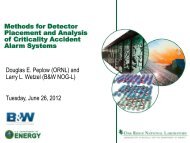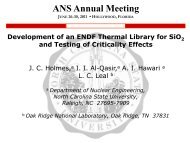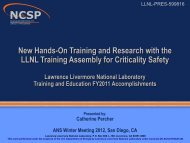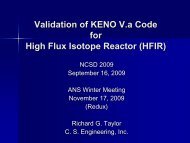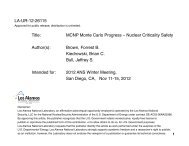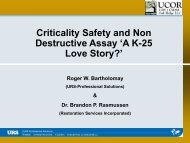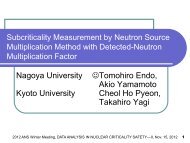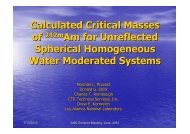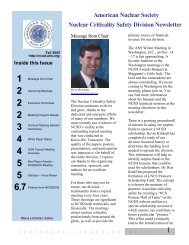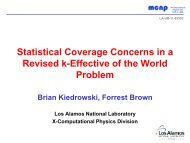Dispelling the Myth of Super-Moderators
Dispelling the Myth of Super-Moderators
Dispelling the Myth of Super-Moderators
You also want an ePaper? Increase the reach of your titles
YUMPU automatically turns print PDFs into web optimized ePapers that Google loves.
Outline• Introduction• Motivation• Basic Theory• Inelastic Scattering• (n, xn’) reactions• Elastic Scattering• ApplicationU N C L A S S I F I E DOperated by Los Alamos National Security, LLC for <strong>the</strong> U.S. Department <strong>of</strong> Energy’s NNSA
Introduction• Disturbing misuse <strong>of</strong> language• Creeping into <strong>of</strong>ficial review comments from auditing agencies— May lead to inappropriate response and redirection <strong>of</strong> alreadytaxed and crucial resources• Case in point super-moderators• Why should we care when presumably <strong>the</strong> intent isknown• We are pr<strong>of</strong>essionals and as such we have an obligation to betechnically accurate• Mentoring new staff is difficult enough without using inaccurateand incorrect terminologyU N C L A S S I F I E DOperated by Los Alamos National Security, LLC for <strong>the</strong> U.S. Department <strong>of</strong> Energy’s NNSA
Basic Theory <strong>of</strong> Moderation• Neutrons slow down via interactions with nuclei• Compound nucleus interactions— Inelastic scattering, (n,n’)— (n, xn’) reactions• Elastic scattering• Compound nucleus reactions• Colliding neutron is captured by <strong>the</strong> nucleus• Threshold reactions• For all but very energetic neutrons <strong>the</strong> inelastic spectrum is discrete• Regardless <strong>the</strong> inelastic spectrum does not include a <strong>the</strong>rmal componentU N C L A S S I F I E DOperated by Los Alamos National Security, LLC for <strong>the</strong> U.S. Department <strong>of</strong> Energy’s NNSA
Reference FramesU N C L A S S I F I E DOperated by Los Alamos National Security, LLC for <strong>the</strong> U.S. Department <strong>of</strong> Energy’s NNSA
Elastic Scattering Energy LossE s 1 2 E s1 1cosIn which A 12 A 1Therefore for forward scattering, i.e., no scatter 0 E s E sNo Energy LossAnd for maximum scatter (head on) 180 E s E sMaximum Energy LossU N C L A S S I F I E DOperated by Los Alamos National Security, LLC for <strong>the</strong> U.S. Department <strong>of</strong> Energy’s NNSA
The Only <strong>Super</strong> Moderator A 1 A 12• For hydrogen A=1 and =0• 1 as A increases• A neutron can• Lose all <strong>of</strong> its energy in a single collision with hydrogen• Lose only a fraction <strong>of</strong> its energy in collisions with all o<strong>the</strong>r nucleiU N C L A S S I F I E DOperated by Los Alamos National Security, LLC for <strong>the</strong> U.S. Department <strong>of</strong> Energy’s NNSA
Hydrogen Is As Good As It GetsNucleusMassNumberMaximumPercentLossAverage #Collisions 2MeV to ThermalHydrogen 1 0 100.0 26Deuterium 2 0.111 88.89 31Beryllium 9 0.640 36.0 92Carbon 12 0.716 28.4 118Oxygen 16 0.779 22.14 155Iron 56 0.931 6.9 518239Pu 239 0.983 1.7 2130U N C L A S S I F I E DOperated by Los Alamos National Security, LLC for <strong>the</strong> U.S. Department <strong>of</strong> Energy’s NNSA
Sources <strong>of</strong> Confusion?• Be moderated systems can have a smaller minimumcritical mass water moderated systems• Moderation by Be and C can lead to lower limitingcritical densities• Poor Nomenclature has resulted from applyingcritical mass results as a “definition” <strong>of</strong> a physicalprocess• Moderation is a process governed by kinematics;• The definition is not linked to critical mass data;• If it were <strong>the</strong> definition would be variableU N C L A S S I F I E DOperated by Los Alamos National Security, LLC for <strong>the</strong> U.S. Department <strong>of</strong> Energy’s NNSA
Critical Mass Curve ComparisonWater Reflected Spherical Systems1.00E+02WaterCarbonBerylliumPure MetalDensity ReductionDominates239 Pu Critical Mass (kg)1.00E+011.00E+00Break Even Points1.00E-011.00E-04 1.00E-03 1.00E-02 1.00E-01 1.00E+00 1.00E+01 1.00E+02239 Pu ConcentrationU N C L A S S I F I E DOperated by Los Alamos National Security, LLC for <strong>the</strong> U.S. Department <strong>of</strong> Energy’s NNSA
1 2 45 6 78 9 10 More Styles1112 1314 a.nodec { text-decoration:none }1516 a:hover { text-decoration:underline;17 color: red;18 background-color:color: #ccffcc }1920 li em { color: red;21 font-weight:bold }2223 ul { margin-left:75px}24Outlineadvance.html(1 <strong>of</strong> 3)hover pseudoclassactivateddynamically whencursor mouse placedat <strong>the</strong> text (place)12
Break Even Point Values (M c =5.49 Kg)Material c (g/L)x/PuratioMass(kg)ModCoreVolume(L)SystemVolume(L)Hydrogen 1019 21.1 4.36 4.63 70Beryllium 122.4 399 82.4 44.8 217Carbon 17.4 2578 709 315 794U N C L A S S I F I E DOperated by Los Alamos National Security, LLC for <strong>the</strong> U.S. Department <strong>of</strong> Energy’s NNSA
Application• The fact that Be moderated systems has a marginallylower critical mass is <strong>of</strong> no practical importance• The amount <strong>of</strong> material required just to re-establish<strong>the</strong> reactivity to undiluted system is very large• Processes that would encounter such situations are very rare— Experiments designed to test this very attribute— Exotic fuel manufacturing that does not exist as <strong>of</strong> nowU N C L A S S I F I E DOperated by Los Alamos National Security, LLC for <strong>the</strong> U.S. Department <strong>of</strong> Energy’s NNSA
5 kg Single Parameter Subcritical LimitUnit Size ComparisonU N C L A S S I F I E DOperated by Los Alamos National Security, LLC for <strong>the</strong> U.S. Department <strong>of</strong> Energy’s NNSA
Reflectors• There are conditions in which <strong>the</strong>re are reflectingmaterials superior to water• Generalizations are just a imprudent in <strong>the</strong> case <strong>of</strong> reflectors as in<strong>the</strong> case <strong>of</strong> moderators• There are <strong>the</strong> same multiple competing factors <strong>of</strong> scattering thateffects leakage, moderation, and absorptionU N C L A S S I F I E DOperated by Los Alamos National Security, LLC for <strong>the</strong> U.S. Department <strong>of</strong> Energy’s NNSA
Conclusion• The language used by pr<strong>of</strong>essionals needs to becorrect, particularly in a safety discipline• Basic collision dynamics demonstrates <strong>the</strong>re is nobetter moderator than hydrogen• Smaller critical masses for Be are not due to superiormoderation but less absorption and leakage• In all but esoteric applications it is not a practicalconcernU N C L A S S I F I E DOperated by Los Alamos National Security, LLC for <strong>the</strong> U.S. Department <strong>of</strong> Energy’s NNSA




